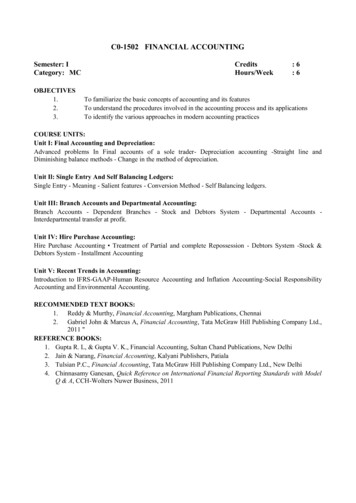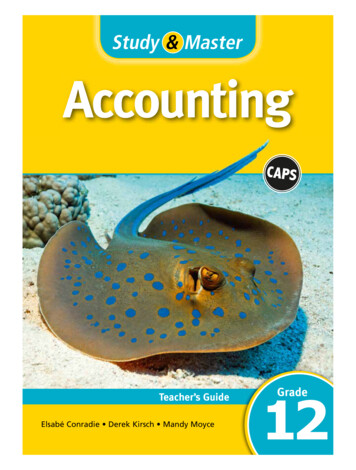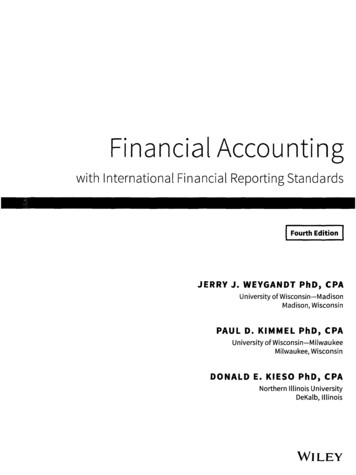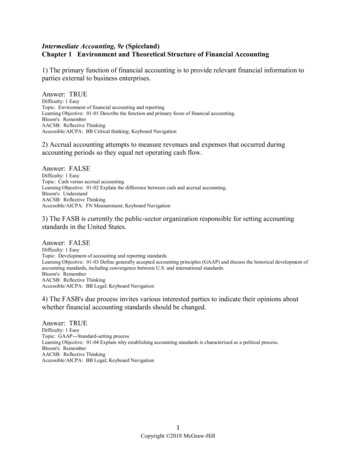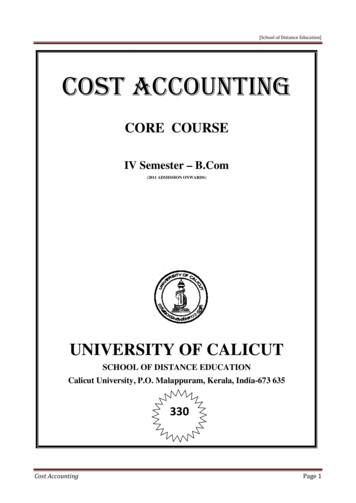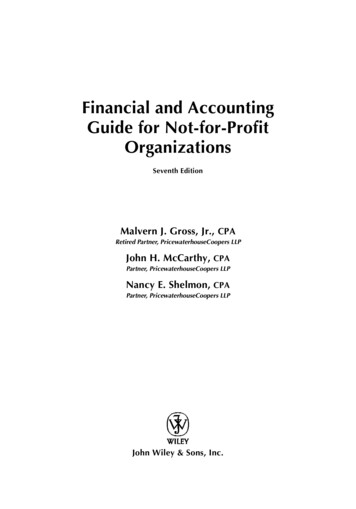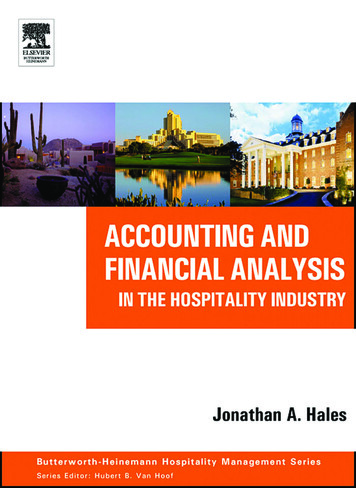
Transcription
Accounting andFinancial Analysisin the HospitalityIndustry
Accounting andFinancial Analysisin the HospitalityIndustryJONATHAN A. HALESAMSTERDAM BOSTON HEIDELBERG LONDONNEW YORK OXFORD PARIS SAN DIEGOSAN FRANCISCO SINGAPORE SYDNEY TOKYO
Elsevier Butterworth–Heinemann30 Corporate Drive, Suite 400, Burlington, MA 01803, USALinacre House, Jordan Hill, Oxford OX2 8DP, UKCopyright 2005, Elsevier Inc. All rights reserved.No part of this publication may be reproduced, stored in a retrieval system, or transmitted in any form or byany means, electronic, mechanical, photocopying, recording, or otherwise, without the prior written permissionof the publisher.Permissions may be sought directly from Elsevier’s Science & Technology Rights Department in Oxford, UK:phone: ( 44) 1865 843830, fax: ( 44) 1865 853333, e-mail: permissions@elsevier.com.uk. You may also completeyour request on-line via the Elsevier homepage (http://elsevier.com), by selecting “Customer Support” and then“Obtaining Permissions.”Front Cover Photo Credits L–RFour Seasons Resort, Scottsdale, AZOrlando World Center Marriott Resort and Conference Center, Orlando, FLOtesaga Hotel, Cooperstown, NYBack Cover Photo CreditWeKoPa Golf Club in Fort McDowell, Fountain Hills, AZRecognizing the importance of preserving what has been written, Elsevier prints its books on acid-free paperwhenever possible.Library of Congress Cataloging-in-Publication DataHales, Jon.Accounting and financial analysis in the accounting industry / Jon Hales.p. cm.Includes index.ISBN 0-7506-7896-81. Hospitality industry—Accounting. I. Title.HF5686.H75H33 2005657 .837—dc222005009790British Library Cataloguing-in-Publication DataA catalogue record for this book is available from the British Library.ISBN: 978-0-7506-7896-4ISBN: 0-7506-7896-8For information on all Elsevier Butterworth–Heinemann publicationsvisit our Web site at www.books.elsevier.comPrinted in the United States of America05 06 07 08 09 10 10 9 8 7 6 5 4 3 2 1Working together to growlibraries in developing countrieswww.elsevier.com www.bookaid.org www.sabre.org
ContentsPreface . . . . . . . . . . . . . . . . . . . . . . . . . . . . . . . . . . . . . . . . . . . . . . . . . . . .ixForeword . . . . . . . . . . . . . . . . . . . . . . . . . . . . . . . . . . . . . . . . . . . . . . . . . .xiiiChapter 1Introduction to Numbers, Accounting, and Financial Analysis1Numbers: The Lifeblood of Business . . . . . . . . . . . . . . . . . . . . . . . . . . . . . .3Career Success Model . . . . . . . . . . . . . . . . . . . . . . . . . . . . . . . . . . . . . . . . .6The Three Main Financial Statements . . . . . . . . . . . . . . . . . . . . . . . . . . . . . .9Revenues: The Beginning of Financial Performance . . . . . . . . . . . . . . . . . . . .15Profit: The Ultimate Measure of Financial Performance . . . . . . . . . . . . . . . . .20Summary . . . . . . . . . . . . . . . . . . . . . . . . . . . . . . . . . . . . . . . . . . . . . . . . . .23Hospitality Manager Takeaways . . . . . . . . . . . . . . . . . . . . . . . . . . . . . . . . . .24Key Terms . . . . . . . . . . . . . . . . . . . . . . . . . . . . . . . . . . . . . . . . . . . . . . . . . .24Formulas . . . . . . . . . . . . . . . . . . . . . . . . . . . . . . . . . . . . . . . . . . . . . . . . . . .25Review Questions . . . . . . . . . . . . . . . . . . . . . . . . . . . . . . . . . . . . . . . . . . . .26Chapter 2Foundations of Financial Analysis . . . . . . . . . . . . . . . . . . . . .27Fundamental Methods of Financial Analysis . . . . . . . . . . . . . . . . . . . . . . . . .28Comparing Numbers to Give Them Meaning . . . . . . . . . . . . . . . . . . . . . . . . .30Measuring Change to Explain Performance . . . . . . . . . . . . . . . . . . . . . . . . . .32Using Percentages in Financial Analysis . . . . . . . . . . . . . . . . . . . . . . . . . . . .34Four Types of Percentages Used in Financial Analysis . . . . . . . . . . . . . . . . . .35Trends in Financial Analysis . . . . . . . . . . . . . . . . . . . . . . . . . . . . . . . . . . . . .39Summary . . . . . . . . . . . . . . . . . . . . . . . . . . . . . . . . . . . . . . . . . . . . . . . . . .41Hospitality Manager Takeaways . . . . . . . . . . . . . . . . . . . . . . . . . . . . . . . . . .42Key Terms . . . . . . . . . . . . . . . . . . . . . . . . . . . . . . . . . . . . . . . . . . . . . . . . . .42Formulas . . . . . . . . . . . . . . . . . . . . . . . . . . . . . . . . . . . . . . . . . . . . . . . . . . .43Review Questions . . . . . . . . . . . . . . . . . . . . . . . . . . . . . . . . . . . . . . . . . . . .43Problems . . . . . . . . . . . . . . . . . . . . . . . . . . . . . . . . . . . . . . . . . . . . . . . . . .43v
TABLE OF CONTENTSChapter 3Accounting Department Organization and Operations . . . . .47Organization Charts . . . . . . . . . . . . . . . . . . . . . . . . . . . . . . . . . . . . . . . . . . .48Accounting Operations in Full-Service Hotels . . . . . . . . . . . . . . . . . . . . . . . .57Accounting Operations in Restaurants and Smaller Hotels . . . . . . . . . . . . . . .62Summary . . . . . . . . . . . . . . . . . . . . . . . . . . . . . . . . . . . . . . . . . . . . . . . . . .64Hospitality Manager Takeaways . . . . . . . . . . . . . . . . . . . . . . . . . . . . . . . . . .65Key Terms . . . . . . . . . . . . . . . . . . . . . . . . . . . . . . . . . . . . . . . . . . . . . . . . . .65Review Questions . . . . . . . . . . . . . . . . . . . . . . . . . . . . . . . . . . . . . . . . . . . .66Chapter 4The Profit and Loss (P&L) Statement . . . . . . . . . . . . . . . . . . .67Hotel Consolidated P&L Statements . . . . . . . . . . . . . . . . . . . . . . . . . . . . . . .69Formats for a Consolidated P&L . . . . . . . . . . . . . . . . . . . . . . . . . . . . . . . . . .75Department P&L Statements . . . . . . . . . . . . . . . . . . . . . . . . . . . . . . . . . . . .82Summary . . . . . . . . . . . . . . . . . . . . . . . . . . . . . . . . . . . . . . . . . . . . . . . . . .84Hospitality Manager Takeaways . . . . . . . . . . . . . . . . . . . . . . . . . . . . . . . . . .85Key Terms . . . . . . . . . . . . . . . . . . . . . . . . . . . . . . . . . . . . . . . . . . . . . . . . . .86Review Questions . . . . . . . . . . . . . . . . . . . . . . . . . . . . . . . . . . . . . . . . . . . .87Chapter 5The Balance Sheet (A&L) and Statement of Cash Flow . . . . .89The Balance Sheet or Asset and Liability (A&L) Statement . . . . . . . . . . . . . . .90Working Relationships between the Balance Sheet and the P&L Statement . .99The Statement of Cash Flow . . . . . . . . . . . . . . . . . . . . . . . . . . . . . . . . . . . .101Summary . . . . . . . . . . . . . . . . . . . . . . . . . . . . . . . . . . . . . . . . . . . . . . . . . .107Hospitality Manager Takeaways . . . . . . . . . . . . . . . . . . . . . . . . . . . . . . . . . .108Key Terms . . . . . . . . . . . . . . . . . . . . . . . . . . . . . . . . . . . . . . . . . . . . . . . . . .108Review Questions . . . . . . . . . . . . . . . . . . . . . . . . . . . . . . . . . . . . . . . . . . . .109Chapter 6Hotel Management Reports . . . . . . . . . . . . . . . . . . . . . . . . . . 111viInternal Hotel Management Reports . . . . . . . . . . . . . . . . . . . . . . . . . . . . . . .112Daily Reports . . . . . . . . . . . . . . . . . . . . . . . . . . . . . . . . . . . . . . . . . . . . . . .113Weekly Internal Management Reports . . . . . . . . . . . . . . . . . . . . . . . . . . . . . .125Monthly Internal Management Reports . . . . . . . . . . . . . . . . . . . . . . . . . . . . .127Summary . . . . . . . . . . . . . . . . . . . . . . . . . . . . . . . . . . . . . . . . . . . . . . . . . .131
TABLE OF CONTENTSHospitality Manager Takeaways . . . . . . . . . . . . . . . . . . . . . . . . . . . . . . . . . .132Key Terms . . . . . . . . . . . . . . . . . . . . . . . . . . . . . . . . . . . . . . . . . . . . . . . . . .132Review Questions . . . . . . . . . . . . . . . . . . . . . . . . . . . . . . . . . . . . . . . . . . . .133Chapter 7Revenue Management . . . . . . . . . . . . . . . . . . . . . . . . . . . . . . 135REVPAR: Revenue per Available Room . . . . . . . . . . . . . . . . . . . . . . . . . . . . .136Rate Structures and Market Segments . . . . . . . . . . . . . . . . . . . . . . . . . . . . .141Revenue Management Systems . . . . . . . . . . . . . . . . . . . . . . . . . . . . . . . . . .143Selling Strategies . . . . . . . . . . . . . . . . . . . . . . . . . . . . . . . . . . . . . . . . . . . . .147Summary . . . . . . . . . . . . . . . . . . . . . . . . . . . . . . . . . . . . . . . . . . . . . . . . . .149Hospitality Manager Takeaways . . . . . . . . . . . . . . . . . . . . . . . . . . . . . . . . . .150Key Terms . . . . . . . . . . . . . . . . . . . . . . . . . . . . . . . . . . . . . . . . . . . . . . . . . .150Review Questions . . . . . . . . . . . . . . . . . . . . . . . . . . . . . . . . . . . . . . . . . . . .151Chapter 8Comparison Reports and Financial Analysis . . . . . . . . . . . . . 153Profitability: The Best Measure of Financial Performance . . . . . . . . . . . . . . . .154Review of Chapter 2: Foundations of Financial Analysis . . . . . . . . . . . . . . . . .159Variation Analysis . . . . . . . . . . . . . . . . . . . . . . . . . . . . . . . . . . . . . . . . . . . .161STAR Market Report . . . . . . . . . . . . . . . . . . . . . . . . . . . . . . . . . . . . . . . . . .167Summary . . . . . . . . . . . . . . . . . . . . . . . . . . . . . . . . . . . . . . . . . . . . . . . . . .170Hospitality Manager Takeaways . . . . . . . . . . . . . . . . . . . . . . . . . . . . . . . . . .170Key Terms . . . . . . . . . . . . . . . . . . . . . . . . . . . . . . . . . . . . . . . . . . . . . . . . . .171Review Questions . . . . . . . . . . . . . . . . . . . . . . . . . . . . . . . . . . . . . . . . . . . .171Chapter 9Forecasting: A Very Important Management Tool . . . . . . . . . 173Forecasting Fundamentals . . . . . . . . . . . . . . . . . . . . . . . . . . . . . . . . . . . . . .175Types and Uses of Forecasts . . . . . . . . . . . . . . . . . . . . . . . . . . . . . . . . . . . .176Revenue Forecasting . . . . . . . . . . . . . . . . . . . . . . . . . . . . . . . . . . . . . . . . . .182Wage Forecasting and Scheduling . . . . . . . . . . . . . . . . . . . . . . . . . . . . . . . .184Summary . . . . . . . . . . . . . . . . . . . . . . . . . . . . . . . . . . . . . . . . . . . . . . . . . .185Hospitality Manager Takeaways . . . . . . . . . . . . . . . . . . . . . . . . . . . . . . . . . .186Key Terms . . . . . . . . . . . . . . . . . . . . . . . . . . . . . . . . . . . . . . . . . . . . . . . . . .186Review Questions . . . . . . . . . . . . . . . . . . . . . . . . . . . . . . . . . . . . . . . . . . . .187Problems . . . . . . . . . . . . . . . . . . . . . . . . . . . . . . . . . . . . . . . . . . . . . . . . . .187vii
TABLE OF CONTENTSChapter 10Budgets . . . . . . . . . . . . . . . . . . . . . . . . . . . . . . . . . . . . . . . . . 229The Use of Budgets in Business Operations . . . . . . . . . . . . . . . . . . . . . . . . .231Annual Operating Budgets . . . . . . . . . . . . . . . . . . . . . . . . . . . . . . . . . . . . . .234Formulas and Steps in Preparing a Budget . . . . . . . . . . . . . . . . . . . . . . . . . .236Capital Expenditure Budgets . . . . . . . . . . . . . . . . . . . . . . . . . . . . . . . . . . . .240Summary . . . . . . . . . . . . . . . . . . . . . . . . . . . . . . . . . . . . . . . . . . . . . . . . . .243Hospitality Manager Takeaways . . . . . . . . . . . . . . . . . . . . . . . . . . . . . . . . . .243Key Terms . . . . . . . . . . . . . . . . . . . . . . . . . . . . . . . . . . . . . . . . . . . . . . . . . .244Review Questions . . . . . . . . . . . . . . . . . . . . . . . . . . . . . . . . . . . . . . . . . . . .244Problems . . . . . . . . . . . . . . . . . . . . . . . . . . . . . . . . . . . . . . . . . . . . . . . . . .245Chapter 11Corporate Annual Reports . . . . . . . . . . . . . . . . . . . . . . . . . . . 249The Purpose of Corporate Annual Reports . . . . . . . . . . . . . . . . . . . . . . . . . .251The Message to Shareholders . . . . . . . . . . . . . . . . . . . . . . . . . . . . . . . . . . .254The Content of the Corporate Annual Report . . . . . . . . . . . . . . . . . . . . . . . .257Financial Results for the Year . . . . . . . . . . . . . . . . . . . . . . . . . . . . . . . . . . . .261Summary . . . . . . . . . . . . . . . . . . . . . . . . . . . . . . . . . . . . . . . . . . . . . . . . . .262Hospitality Manager Takeaways . . . . . . . . . . . . . . . . . . . . . . . . . . . . . . . . . .263Key Terms . . . . . . . . . . . . . . . . . . . . . . . . . . . . . . . . . . . . . . . . . . . . . . . . . .263Review Questions . . . . . . . . . . . . . . . . . . . . . . . . . . . . . . . . . . . . . . . . . . . .264Chapter 12Personal Financial Literacy . . . . . . . . . . . . . . . . . . . . . . . . . . 265Personal Financial Literacy . . . . . . . . . . . . . . . . . . . . . . . . . . . . . . . . . . . . . .viii266Managing Personal Finances . . . . . . . . . . . . . . . . . . . . . . . . . . . . . . . . . . . .271Evaluating Assets and Sources of Income . . . . . . . . . . . . . . . . . . . . . . . . . . .274Summary . . . . . . . . . . . . . . . . . . . . . . . . . . . . . . . . . . . . . . . . . . . . . . . . . .276Hospitality Manager Takeaways . . . . . . . . . . . . . . . . . . . . . . . . . . . . . . . . . .277Key Terms . . . . . . . . . . . . . . . . . . . . . . . . . . . . . . . . . . . . . . . . . . . . . . . . . .277Review Questions . . . . . . . . . . . . . . . . . . . . . . . . . . . . . . . . . . . . . . . . . . . .278Glossary . . . . . . . . . . . . . . . . . . . . . . . . . . . . . . . . . . . . . . . . . . . . . . . . . . .279Index . . . . . . . . . . . . . . . . . . . . . . . . . . . . . . . . . . . . . . . . . . . . . . . . . . . . .287
PrefaceMost hospitality programs in the United States require several accounting classes as partof their curriculum. Although these accounting classes are important and provide theknowledge and skills that every hospitality manager will need, students are generallyafraid of, do not like, have high anxiety levels about, and do not do well in these classes.Often the result is that they just try to survive the class and do not try to understand andlearn the accounting and finance concepts presented in the class that will help them intheir hospitality careers.This textbook seeks to reduce students’ fears and anxieties by focusing on the fundamentals of using numbers in operating a business. This means focusing on the essentialfundamentals that are easier to understand and apply. It means teaching students to usenumbers in hospitality operations. It does not include the accounting details and complexity that are used by Directors of Finance and CPAs. The focus is on using financialreports in operating the departments, not on preparing accounting reports.Fundamental accounting concepts and methods of financial analysis are important skills forgraduating students to understand and possess as they begin their hospitality careers.They should have a solid foundation of accounting knowledge and fundamentals that willenable them to quickly learn, understand, and apply the accounting policies and procedures of the hospitality company that they work for. This understanding often means thedifference between steady career advancement and no advancement at all.Hospitality students need to have a fundamental understanding of using numbers inoperating their departments and analyzing their financial statements. This textbook iswritten to present and focus on the following important goals in teaching hospitalityaccounting:1. Presenting students with accounting information that will provide a solid foundation of fundamental accounting concepts and methods of financial analysis.2. Teaching students to understand numbers and be able to use numbers to help themperform their managerial responsibilities more effectively.ix
PREFACE3. Assisting students in understanding that using financial analysis to evaluate business operations involves basic arithmetic and fundamental formulas and need notbe complicated and overwhelming.4. Teaching students to understand that numbers resulting from operations are usedas a management tool and a means to measure financial performance.5. Enabling students to apply accounting concepts and methods of financial analysisin managing their operations and evaluating financial statements.This textbook was written to provide hospitality students and hospitality managerswith a solid foundation of accounting concepts and methods of financial analysis that theywill need to use in their jobs in the hospitality industry. The Directors of Finance for severalmajor hotel companies have reviewed a major portion of the material. Their input wasinstrumental in enabling the material presented in this textbook to be consistent with theactual accounting processes and procedures used in the hospitality industry.This textbook is written for students who desire to become hospitality operations managers and not Assistant Controllers, Controllers, or Directors of Finance. It is critical thathospitality managers be able to understand numbers and use them in the daily operationsof their departments. Accounting fundamentals and accounting applications to operationsare the main themes of this book.Chapters 1 and 2 provide an introduction to accounting and a solid foundation ofaccounting concepts and methods of financial analysis. The focus is on the fundamentalsof using numbers in hospitality operations. Chapter 3 explains the organization and operation of the accounting department in a hotel. This is intended to help hospitality studentsunderstand how accounting department operations fit into hotel operations and how theycan help hospitality managers operate their departments.Chapters 4 through 8 discuss the three main financial statements used in financialanalysis and hotel management reports that are used as management tools and to measurefinancial performance. The purpose is to introduce students to the actual use and application of financial reports in the operations of departments within a hotel or restaurant.The focus is to present accounting and financial information that students will need toknow and be able to use in managing their departments.Chapters 9 and 10 emphasize the importance of forecasting and budgeting as a management tool and as a way to measure financial performance. Forecasting revenues andscheduling wages are two important responsibilities of hospitality managers. Thesechapters focus on the importance of a manger’s ability to review current operations andto prepare weekly forecasts that update the budget and reflect current market conditions.Chapters 11 and 12 are intended to provide students with additional knowledge tobroaden their financial skills and understanding. Chapter 12 is intended to encouragestudents to apply fundamental financial skills to their personal management of money.x
PREFACEThe glossary summarizes key terms presented in the text that students should know.As students read this text and progress through a hospitality accounting course, itis the author’s hope and intent that they will be able to learn fundamental accountingconcepts and use methods of financial analysis in operating their departments when theystart their hospitality careers. By focusing on accounting fundamentals and buildingon accounting concepts, student fears and anxieties of accounting will be replaced with asolid and useful understanding of accounting that they will be able to use and apply intheir hospitality careers.Jonathan A. Halesxi
ForewordThe Butterworth-Heinemann Hospitality Management Series covers all aspects of themanagement of hospitality enterprises from an applied perspective. Each book in the seriesprovides an introduction to a separate managerial function such as human resources oraccounting, to a distinct management segment in the hospitality industry such as clubmanagement, resort management, or casino management, as well as to other topic areasclosely related to hospitality management, such as information technology, ethics, or services management.The books in the series are written for students in two- and four-year hospitality management programs, as well as entry- and mid-level managers in the hospitality industry.They present readers with three essential features they are looking for in textbooks nowadays: these books are affordable, they are high quality, and their applied and to-the-pointapproach to hospitality management issues appeals to students and instructors alike. Theauthors in the series are selected because of their expertise and their ability to makecomplex materials easy to understand.Accounting and Financial Analysis in the Hospitality Industry by Dr. Jon Hales is the firsttext in this series. Because of his industry experience (Dr. Hales served as a Controller,Resident Manager, and General Manager at six properties for the Marriott Corporation for25 years) and his educational experience as a college-level instructor, Dr. Hales knowsexactly what students and entry-level managers need to be aware of when it comes tomanagerial accounting. He also has the educational expertise to convey this knowledgein a very applied and easy-to-understand format, as he teaches this subject every day. Thisis what you need to know about managerial accounting and what the numbers tell youwhen you leave school and become a manager!Students and educators alike will find affordability, relevance and high quality in thisand all other texts in the series. As we say in the hospitality industry: welcome and enjoy!Hubert B. Van Hoof, Ph.D.Series Editorxiii
1Introduction to Numbers, Accounting,and Financial AnalysisLearning Objectives1. To understand the three most common measurements of a company’s success.2. To recognize how important understanding accounting and finance is to the career ofany hospitality manager.3. To learn about and describe the three fundamental financial statements.4. To become familiar with fundamental revenue accounting concepts.5. To understand fundamental profit accounting concepts.6. To learn the revenue and profit formulas.Chapter OutlineNumbers: The Lifeblood of BusinessAccounting ConceptCustomers, Associates, and ProfitabilityCareer Success ModelTechnical SkillsManagement/Leadership SkillsFinancial SkillsMarketing SkillsHigh-Performance OrganizationsThe Three Main Financial StatementsProfit and Loss StatementBalance SheetStatement of Cash Flows1
CHAPTER 1 INTRODUCTION TO NUMBERS, ACCOUNTING, AND FINANCIAL ANALYSISRevenues: The Beginning of Financial PerformanceFormulasMarket SegmentsThe CustomerProfit: The Ultimate Measure of Financial PerformanceDepartment ProfitHouse Profit (Marriott) or Gross Operating Profit (Hyatt and Four Seasons)Net House Profit or Adjusted Gross Operating ProfitProfit Before and After TaxesSummaryHospitality Manager TakeawaysKey TermsFormulasReview QuestionsAccounting concepts and methods of financial analysis generally sound intimidating andcomplicated. Visions of CPAs, financial advisors, tax laws, attorneys, big ugly books,spreadsheets, paperwork nightmares, and migraine headaches regularly accompanyany mention of accounting and finance. And this is often the case. However, entry-levelhospitality managers need to be able to use accounting concepts and methods of financialanalysis to conduct the daily operations of their departments. They need to understandthem and be able to effectively apply them to their department operations.Numbers are also used to measure a company’s performance in meeting expectedstrategies, goals, and objectives. Typically, there are three commonly used measurementsof success:Customer satisfactionEmployee satisfactionProfitability and cash flowPerformance is measured and defined against these goals with the use of numbers.This chapter introduces fundamental accounting concepts and explains how numbersare used to apply these accounting concepts to daily operations. It likewise introduces fundamental methods of financial analysis and explains how numbers are used to performfinancial analysis. The objective is, first, to understand these fundamental concepts;second, to be comfortable working with them; and, third, to be able to apply them. Sub-2
NUMBERS: THE LIFEBLOOD OF BUSINESSsequent chapters will go into more detail and build on the foundation developed in thischapter.Numbers: The Lifeblood of BusinessNumbers—understanding them and working with them—form the foundation of bothaccounting concepts and methods of financial analysis. Numbers provide descriptions andmeasurements that relate to the operations of a business. Let’s define a few terms.Accounting ConceptAccounting refers to the bookkeeping methods involved in making a financial record ofbusiness transactions and in the preparation of statements concerning the assets, liabilities, and operating results of a business. A concept is a general understanding, especiallyone derived from a particular instance or occurrence. These definitions are from Webster’sdictionary and not from an accounting book. We combine the two definitions and theresulting definition of accounting concepts is a general understanding of the bookkeepingmethods and financial transactions of a business.Financial Analysis: Finance is the management of monetary affairs. Analysis is theseparation of an intellectual or substantial whole into its parts for individual study. Thesedefinitions are also from Webster’s dictionary. We combine the two definitions, and ourdefinition of financial analysis is the separation of the management of monetary affairs of a business into parts for individual study.Fundamental arithmetic is all that is required to use and apply numbers to understandbusiness operations. Two of the most important formulas in financial analysis only requiremultiplication and subtraction:Revenue Rate VolumeProfit Revenues - ExpensesAlthough these two formulas can be applied to many market segments, departments, andvolume levels and can become rather detailed, the fact remains they are each calculatedwith arithmetic and not calculus, trigonometry, or college algebra.There is a common theme in today’s business world about how to measure the successof a company or business. It involves satisfied customers, satisfied employees, and satisfactory profitability. As an example, we can look at one of the largest and most successfulcompanies in the world to examine these concepts.By two important measurements—market capitalization and recognition—GeneralElectric (GE) is a company we can learn from. In 2003, GE was the largest company in theworld in terms of market capitalization. The formula for market capitalization is the stock3
CHAPTER 1 INTRODUCTION TO NUMBERS, ACCOUNTING, AND FINANCIAL ANALYSISprice times the number of shares of stock outstanding. To be the largest capitalizedcompany in the world means that more individuals and institutions are investing in GEthan in any other company, which is quite an accomplishment. GE was also the MostAdmired Company in the United States from 1997 to 2001 and in 2005 was #2 on the MostAdmired Company List according to Fortune magazine. Former CEO Jack Welch, in discussing the GE management philosophy in Jack Welch and the GE Way by Robert Slater(1999), is quoted as saying:We always say that if you had three measurements to live by, they’d be employee satisfaction, customer satisfaction and cash flow. If you’ve got cash in the till at the end,the rest is all going to work, because if you’ve got high customer satisfaction, you’regoing to get a share. If you’ve got high employee satisfaction you’re going to get productivity. And if you’ve got cash, you know it’s all working. (p. 90)This statement highlights the relationship or balance between three essential ingredients of a successful business: customers, employees, and profitability. These three measurements are interrelated, and problems with one will lead to problems with the others.Numbers are involved in measuring the success of each of these measurements.Customers, Employees, and ProfitabilityCustomer satisfaction can be measured by percentage of market share, percentage ofrevenue growth, or the successful introduction of new products and services. All of thesemeasurements use numbers. For example, market share can increase from 7% to 8%. Thistells us that customers are buying more of our products, and our sales have now increasedfrom 7% to 8% of the total market. If a company’s market share is growing, it means thatcustomers choose to buy its products over those of the competitors because of quality,value, or both. That is obviously a good thing. If our market share is declining, that meanscustomers are not buying as many of our products and services, and that is a bad thing.Numbers tell us to what degree our business is improving or declining.Another way to measure customer satisfaction is with customer satisfaction surveys.This process provides direct customer feedback based on questions asked in a survey.A typical question is “Are you willing to return?” The hotel will have a historicalscore that shows the performance for the previous year and will set a new goal for thenext year of operations. Each time the current score is reported—generally monthly—it iscompared with the actual score from the previous year to see if the hotel is improving. Itis also compared to the goal for the current year to see if the goal will be missed, met, orexceeded.Employee satisfaction is measured in the same way. Each hotel will have its score fromthe previous year for the questions asked, as well as a goal for the year. The current score4
NUMBERS: THE LIFEBLOOD OF BUSINESSon the survey is compared to these benchmark scores, an
Accounting and Financial Analysis in the Hospitality Industryby Dr. Jon Hales is the first text in this series. Because of his industry experience (Dr. Hales served as a Controller, Resident Manager, and General M

